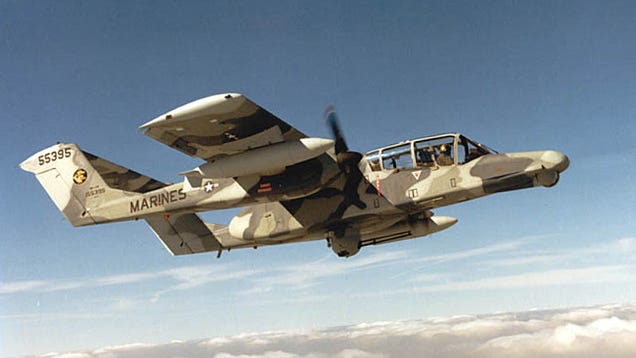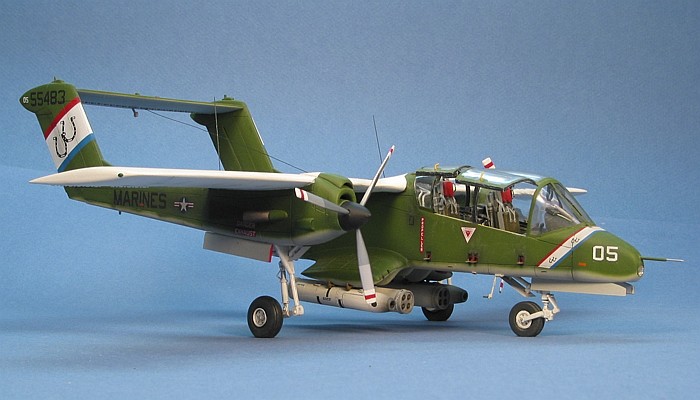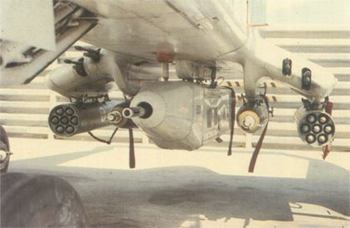Remember the big thread on the OV-10?.....
For links see article source.....
Posted for fair use.....
http://www.thedailybeast.com/articl...using-these-antique-planes-to-fight-isis.html
THROWBACK
03.08.16 9:01 PM ET
Why Is America Using These Antique Planes to Fight ISIS?
The U.S. military is testing a dependable, rugged little vintage bomber as it battles elusive ISIS militants in Syria and Iraq.
David Axe
War was just an experiment for two of the U.S. military’s oldest and most unusual warplanes. A pair of OV-10 Broncos—small, Vietnam War-vintage, propeller-driven attack planes—recently spent three months flying top cover for ground troops battling ISIS militants in the Middle East.
The OV-10s’ deployment is one of the latest examples of a remarkable phenomenon. The United States—and, to a lesser extent, Russia—has seized the opportunity afforded it by the aerial free-for-all over Iraq and Syria and other war zones to conduct live combat trials with new and upgraded warplanes, testing the aircraft in potentially deadly conditions before committing to expensive manufacturing programs.
That’s right. America’s aerial bombing campaigns are also laboratories for the military and the arms industry. After all, how better to pinpoint an experimental warplane’s strengths and weaknesses than to send it into an actual war?
The twin-engine Broncos—each flown by a pair of naval aviators—completed 134 sorties, including 120 combat missions, over a span of 82 days beginning in May 2015 or shortly thereafter, according to U.S. Central Command, which oversees America’s wars in the Middle East and Afghanistan.
Central Command would not say exactly where the OV-10s were based or where they attacked, but did specify that the diminutive attack planes with their distinctive twin tail booms flew in support of Operation Inherent Resolve, the U.S.-led international campaign against ISIS in Iraq and Syria. The Pentagon has deployed warplanes to Turkey, Kuwait, Qatar, Jordan, and the United Arab Emirates, among other countries.
There are plenty of clues as to what exactly the Broncos were doing. For one, the Pentagon’s reluctance to provide many details about the OV-10s’ overseas missions implies that the planes were working in close conjunction with Special Operations Forces. In all likelihood, the tiny attackers acted as a kind of quick-reacting 9-1-1 force for special operators, taking off quickly at the commandos’ request and flying low to hit elusive militants with guns and rockets, all before the fleet-flooted jihadis could slip away.
The military’s goal was “to determine if properly employed turbo-prop driven aircraft… would increase synergy and improve the coordination between the aircrew and ground commander,” Air Force Capt. P. Bryant Davis, a Central Command spokesman, told The Daily Beast.
Davis said that the military also wanted to know if Broncos or similiar planes could take over for jet fighters such as F-15s and F/A-18s, which conduct most of America’s airstrikes in the Middle East but are much more expensive to buy and operate than a propeller-driven plane like the OV-10. An F-15 can cost as much as $40,000 per flight-hour just for fuel and maintenance. By contrast, a Bronco can cost as little as $1,000 for an hour of flying.
Indeed, that was the whole point of the OV-10 when North American Aviation, now part of Boeing, developed the Bronco way back in the 1960s. The Pentagon wanted a small, cheap attack plane that could take off from rough airstrips close to the fighting. By sticking close to the front lines, the tiny planes would always be available to support ground troops trying to root out insurgent forces.
The Bronco turned out to be just the thing the military needed. The Air Force, Navy, and Marine Corps deployed hundreds of OV-10s in Vietnam, where the tiny planes proved rugged, reliable, and deadly to the enemy. After Vietnam, the Navy retired its Broncos and the Air Force swapped its own copies for jet-powered A-10s, but the Marines hung onto the dependable little bombers and even flew them from small Navy aircraft carriers before finally retiring them in the mid-1990s.
Foreign air forces and civilian and paramilitary operators quickly snatched up the decommissioned Broncos. They proved popular with firefighting agencies. The Philippines deployed OV-10s to devastating effect in its counterinsurgency campaign against Islamic militants. The U.S. State Department sent Broncos to Colombia to support the War on Drugs. NASA used them for airborne tests.
Thirty years after Vietnam, the Pentagon again found itself fighting elusive insurgents in Afghanistan, Iraq and other war zones. It again turned to the OV-10 for help. In 2011, Central Command and Special Operations Command borrowed two former Marine Corps Broncos—from NASA or the State Department, apparently—and fitted them with new radios and weapons.
The Defense Department slipped $20 million into its 2012 budget to pay for the two OV-10s to deploy overseas—part of a wider military experiment with smaller, cheaper warplanes.
There was certainly precedent for the experiment going back a decade or more. During the 1991 Gulf War, the Air Force deployed a prototype E-8 radar plane to track Iraqi tanks across the desert. The Air Force’s high-flying Global Hawk spy drone was still just a prototype when the Air Force sent it overseas to spy on the Taliban and Al Qaeda in late 2001. Satisfied with both aircraft’s wartime trials, the military ultimately spent billions of dollars buying more of them.
Not to be outdone, in November 2015 Russia sent Tu-160 heavy bombers to strike targets in Syria—the giant bombers’ very first combat mission, and one that many observers assumed was really meant as a test of the planes’ combat capabilities in advance of a planned upgrade program.
Such combat experiments don’t always please everyone. When the Pentagon proposed to spend $20 million on the OV-10s, Sen. John McCain, the penny-pinching Arizona Republican who now chairs the Senate Armed Services Committee, objected. “There is no urgent operational requirement for this type of aircraft,” McCain said in a statement. Lawmakers subsequently canceled most of the Broncos’ funding, but the military eventually succeeded in paying for the trial by diverting money from other programs.
The OV-10s proved incredibly reliable in their 82 days of combat, completing 99 percent of the missions planned for them, according to Davis. Today the two OV-10s are sitting idle at a military airfield in North Carolina while testers crunch the numbers from their trial deployment. The assessment will “determine if this is a valid concept that would be effective in the current battlespace,” Central Command spokesman Davis said.
Lt. Gen. Bradley Heithold, the head of Air Force Special Operations Command, has already hinted that the military will stick with its current jet fighters for attack missions. At a February defense-industry conference in Orlando, Heithold said the OV-10s have “some utility,” but added that it’s too expensive to pay for training and supplies for a fleet of just two airplanes. Typically, the Pentagon buys hundreds of planes at a time, partly to achieve economies of scale.
Yes, the OV-10s are cheaper per plane and per flight than, say, an F-15. But for those savings to matter, the military would need to acquire hundreds of Broncos—not two. And that’s not something that planners are willing to do quite yet.
Which is not to say the tiny attackers’ combat trial was a failure. To know for sure whether the Vietnam-veteran OV-10s still had anything to offer, the military had to send them back to war. And lucky for testers, there’s still plenty of war going on.
For links see article source.....
Posted for fair use.....
http://www.thedailybeast.com/articl...using-these-antique-planes-to-fight-isis.html
THROWBACK
03.08.16 9:01 PM ET
Why Is America Using These Antique Planes to Fight ISIS?
The U.S. military is testing a dependable, rugged little vintage bomber as it battles elusive ISIS militants in Syria and Iraq.
David Axe
War was just an experiment for two of the U.S. military’s oldest and most unusual warplanes. A pair of OV-10 Broncos—small, Vietnam War-vintage, propeller-driven attack planes—recently spent three months flying top cover for ground troops battling ISIS militants in the Middle East.
The OV-10s’ deployment is one of the latest examples of a remarkable phenomenon. The United States—and, to a lesser extent, Russia—has seized the opportunity afforded it by the aerial free-for-all over Iraq and Syria and other war zones to conduct live combat trials with new and upgraded warplanes, testing the aircraft in potentially deadly conditions before committing to expensive manufacturing programs.
That’s right. America’s aerial bombing campaigns are also laboratories for the military and the arms industry. After all, how better to pinpoint an experimental warplane’s strengths and weaknesses than to send it into an actual war?
The twin-engine Broncos—each flown by a pair of naval aviators—completed 134 sorties, including 120 combat missions, over a span of 82 days beginning in May 2015 or shortly thereafter, according to U.S. Central Command, which oversees America’s wars in the Middle East and Afghanistan.
Central Command would not say exactly where the OV-10s were based or where they attacked, but did specify that the diminutive attack planes with their distinctive twin tail booms flew in support of Operation Inherent Resolve, the U.S.-led international campaign against ISIS in Iraq and Syria. The Pentagon has deployed warplanes to Turkey, Kuwait, Qatar, Jordan, and the United Arab Emirates, among other countries.
There are plenty of clues as to what exactly the Broncos were doing. For one, the Pentagon’s reluctance to provide many details about the OV-10s’ overseas missions implies that the planes were working in close conjunction with Special Operations Forces. In all likelihood, the tiny attackers acted as a kind of quick-reacting 9-1-1 force for special operators, taking off quickly at the commandos’ request and flying low to hit elusive militants with guns and rockets, all before the fleet-flooted jihadis could slip away.
The military’s goal was “to determine if properly employed turbo-prop driven aircraft… would increase synergy and improve the coordination between the aircrew and ground commander,” Air Force Capt. P. Bryant Davis, a Central Command spokesman, told The Daily Beast.
Davis said that the military also wanted to know if Broncos or similiar planes could take over for jet fighters such as F-15s and F/A-18s, which conduct most of America’s airstrikes in the Middle East but are much more expensive to buy and operate than a propeller-driven plane like the OV-10. An F-15 can cost as much as $40,000 per flight-hour just for fuel and maintenance. By contrast, a Bronco can cost as little as $1,000 for an hour of flying.
Indeed, that was the whole point of the OV-10 when North American Aviation, now part of Boeing, developed the Bronco way back in the 1960s. The Pentagon wanted a small, cheap attack plane that could take off from rough airstrips close to the fighting. By sticking close to the front lines, the tiny planes would always be available to support ground troops trying to root out insurgent forces.
The Bronco turned out to be just the thing the military needed. The Air Force, Navy, and Marine Corps deployed hundreds of OV-10s in Vietnam, where the tiny planes proved rugged, reliable, and deadly to the enemy. After Vietnam, the Navy retired its Broncos and the Air Force swapped its own copies for jet-powered A-10s, but the Marines hung onto the dependable little bombers and even flew them from small Navy aircraft carriers before finally retiring them in the mid-1990s.
Foreign air forces and civilian and paramilitary operators quickly snatched up the decommissioned Broncos. They proved popular with firefighting agencies. The Philippines deployed OV-10s to devastating effect in its counterinsurgency campaign against Islamic militants. The U.S. State Department sent Broncos to Colombia to support the War on Drugs. NASA used them for airborne tests.
Thirty years after Vietnam, the Pentagon again found itself fighting elusive insurgents in Afghanistan, Iraq and other war zones. It again turned to the OV-10 for help. In 2011, Central Command and Special Operations Command borrowed two former Marine Corps Broncos—from NASA or the State Department, apparently—and fitted them with new radios and weapons.
The Defense Department slipped $20 million into its 2012 budget to pay for the two OV-10s to deploy overseas—part of a wider military experiment with smaller, cheaper warplanes.
There was certainly precedent for the experiment going back a decade or more. During the 1991 Gulf War, the Air Force deployed a prototype E-8 radar plane to track Iraqi tanks across the desert. The Air Force’s high-flying Global Hawk spy drone was still just a prototype when the Air Force sent it overseas to spy on the Taliban and Al Qaeda in late 2001. Satisfied with both aircraft’s wartime trials, the military ultimately spent billions of dollars buying more of them.
Not to be outdone, in November 2015 Russia sent Tu-160 heavy bombers to strike targets in Syria—the giant bombers’ very first combat mission, and one that many observers assumed was really meant as a test of the planes’ combat capabilities in advance of a planned upgrade program.
Such combat experiments don’t always please everyone. When the Pentagon proposed to spend $20 million on the OV-10s, Sen. John McCain, the penny-pinching Arizona Republican who now chairs the Senate Armed Services Committee, objected. “There is no urgent operational requirement for this type of aircraft,” McCain said in a statement. Lawmakers subsequently canceled most of the Broncos’ funding, but the military eventually succeeded in paying for the trial by diverting money from other programs.
The OV-10s proved incredibly reliable in their 82 days of combat, completing 99 percent of the missions planned for them, according to Davis. Today the two OV-10s are sitting idle at a military airfield in North Carolina while testers crunch the numbers from their trial deployment. The assessment will “determine if this is a valid concept that would be effective in the current battlespace,” Central Command spokesman Davis said.
Lt. Gen. Bradley Heithold, the head of Air Force Special Operations Command, has already hinted that the military will stick with its current jet fighters for attack missions. At a February defense-industry conference in Orlando, Heithold said the OV-10s have “some utility,” but added that it’s too expensive to pay for training and supplies for a fleet of just two airplanes. Typically, the Pentagon buys hundreds of planes at a time, partly to achieve economies of scale.
Yes, the OV-10s are cheaper per plane and per flight than, say, an F-15. But for those savings to matter, the military would need to acquire hundreds of Broncos—not two. And that’s not something that planners are willing to do quite yet.
Which is not to say the tiny attackers’ combat trial was a failure. To know for sure whether the Vietnam-veteran OV-10s still had anything to offer, the military had to send them back to war. And lucky for testers, there’s still plenty of war going on.
Last edited:
















